Marvel Comics were Real Time Comics in the 1960s
Plus: the team's ages

The official view is that Marvel comics took place in
more or less real time until 1968.
On 8th November 2010 on his Formspring
account, Tom Brevoort stated unequivocally that Franklin is 8
years old and it is 13 years since Fantastic Four number 1. In
other words, 5 years passed between FF1 (published late 1961) and
Annual 6 (published early 1968), when in real time, 6 1/2 years
had passed.. However, the art and other evidence suggests that Franklin may be around 6,
indicating that 7 of the 13 Marvel years took place between 1961
and 1968. A couple of years later Brevoort approached the question in a different way, stating it even more clearly:
"In the earliest days, Stan didnít
have any use for anything beyond the broadest version of continuity. And
itís no wonderóhe didnít think these new characters would last for five
years when he started, let alone fifty. So he had the characters aging
more or less in real time, and it was only after seven or eight years
that he started to realize that he needed to slow things down in order
to allow for greater longevity" (source)
A close examination of the stories confirms that. Until 1968 at
least, Marvel comics took place in real time. Here I'll
use the Fantastic Four as a detailed example, but you could also
chart Spider-Man's progress through High School and reach a
similar conclusion. Are you ready? Let's fire up Dr Doom's Time
Machine and go back to the very beginning, back to 1961.....
1961
The events of FF issue 1 are clearly linked to the space race in
1961, and fans loved it!
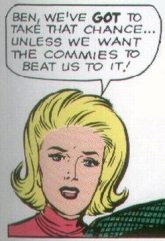
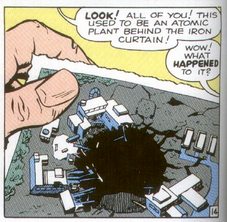
In 1971 (FF126) it was stated that the team's origin took place in
1961:
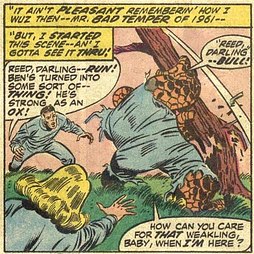
In 1975 (FF160) it was again stated that the events of issue 1 took
place in 1961:

1962
In 1962 Johnny explicitly states it is 1962:
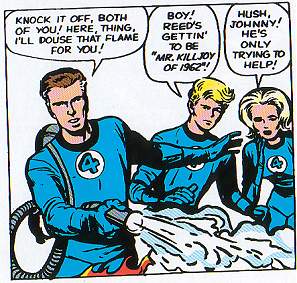
Issue 4 has the return of the Submariner, a 1940s hero. He had his
own comic just ten years earlier (I haven't checked the exact date
his comic was canceled), so the Fantastic Four had to explain what
happened in the mean time. Back then, ten years was a long time!
back then, things happened! Back then, nothing stayed still! Back
then, comics were exciting! So they explained how the Submariner had
lost his memory some time before the nuclear tests of the 1950s
(more real time references). A similar thing happened in the
Avengers when Captain America returned. This was less than twenty
years after WWII, but the real time delay was enough for Stan Lee to
invent a "frozen in ice" story to explain the long delay. A similar
explanation was used for the return of the original Human Torch in
FF annual 4. Back then it was unacceptable for a hero to remain
unchanged for twenty years without a serious explanation! These days
the heroes have remained unchanged for thirty years and nobody cares
any more.
In issue 8 Johnny mentions it is 1962. In issue 9 of the FF
starts with the FF becoming bankrupt. This was written in 1962,
coinciding with a real-world stock market crisis. Then our heroes
visit Hollywood, and on pages 6 and 7 they appear in the same
frames as famous celebrities from 1962.
Johnny Storm's age increases each year
As we continue we will see that Johnny's age increases by one year
every year.
Johnny Storm probably has his 17th birthday in February 1963 (see below). We can
see the passing of time in his own comic, Strange Tales. In 1963
Johnny has exams and says he resents still having to go to school.
In Strange Tales 119, page 2, Reed refers to Johnny's next "summer
vacation," indicating that Reed expects him to continue his
schooling.



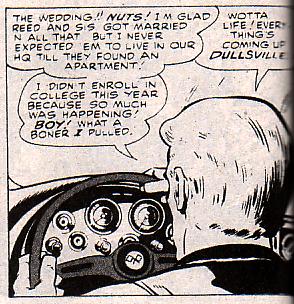
Soon after this we stop hearing of Johnny's school work. Instead he
is seen lazing around the house, dating Dorrie Evans, racing cars,
bowling or playing golf. Previously his exam pressures were building
up, yet now he has plenty of time. The obvious conclusion is that
Johnny graduated from high school but took some time off school. How
much time? The comics' internal chronology (see references above to
"last year" and "a few months ago") suggest that this was quite some
time. Students cannot just take a few months off - it is a year or
nothing. Besides, it is very common for a student to take a gap
year. So we can conclude, based on the comics, that Johnny Storm
took a whole year away from school in 1964, when he was 18 or 19.
This was not yet a big problem. The slippage was only small and
could easily be made up in a later story. More importantly, the
stories were incredibly good, so we can overlook the fact that
they have fewer real-world connections. But the writing was on the
wall, the realism was
weakening.
1968 was Marvel's great turning point. Click
here for details
1963
Johnny explicitly states it is 1963:

FF issue 11 has the FF respond to letters from their readers. They
very clearly live in the same world and same time frame. Issue 1 is
described as being "a year ago" (FF1 was at the very end of 1961),
and issue 6 was "a few months ago."
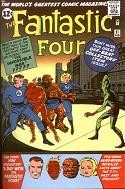
We also learn that Reed and Ben fought in World War II. And the
comic is very specific: Ben was a marine fighter ace who fought over
Okinawa and Guadalcanal, and appeared in the newspapers. Reed worked
for the underground, for the O.S.S., and he dreamed of his childhood
sweetheart, Susan Storm. These people were not timeless icons, they
felt like real life people, living in the real world, and that is
what made their adventures more exciting than other comics.
Issue 17 has a cameo from president John F. Kennedy, and page 12
has his counterparts in Russia. Then issue 19 refers to issue 5 as
"more than a year ago" (exactly a year ago would have been issue
7).

1964
FF issue 28 has their first battle with the X-Men. As so often
happens in these issues, the FF learn about current events by
reading the newspaper, emphasizing both the links with the real
world and the fact that everything back then was always changing.
Issue 33 begins with the headline "SCENE: F.F. HEADQUARTERS! TIME:
NOW!" The story begins with an undersea specimen being sent from the
Coast Guard for Reed to study, and Ben looks in an encyclopedia to
find what it is. The Hate Monger story includes a reference to an
underground tunneling machine, with a note from the editor saying
the Russians are really developing such a thing in the real world.
Everything acts to tie the FF into the real and familiar world of
the readers, which makes the amazing adventures seem even more
amazing.
In Strange Tales 127 (December 1964, on sale in September) we see
that issue 118 (just nine issues earlier) was "last year." And issue
124 was "a few months ago." Clearly this is happening in real time.
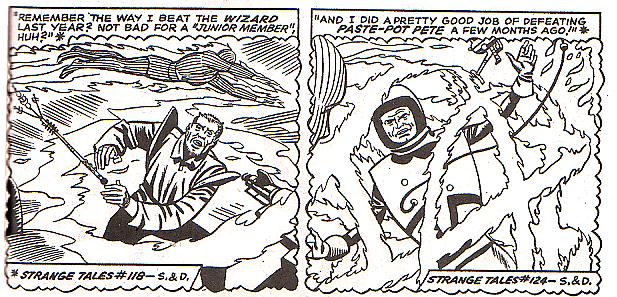
This is confirmed by the text. In previous issues, the Wizard was
twice sent to jail, and each time he "had plenty of time to plan"
and was able to act like a model prisoner for "long enough" to
lull the authorities into complacency. Then he escaped and planned
his next campaign against the torch, all within the space of a few
issues (102-105, 106-110 then 110-118). If this is not happening
in real time there simply isn't enough time for the events to
unfold.
Left: in FF 28 (July 1964), Strange Tales 120 (May 1964) was
described as "a few months ago." In FF 31 (November 1964), FF 18
(the Super Skrull, September 1963) was described as "last year."

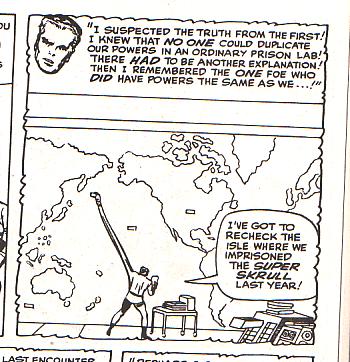
Note that the characters used to remember previous battles, and
each battle was highly significant, because every year was
different, everything was changing, most of the events were new.
Today it's just "Ho hum, looks like it's time to fight the Hulk
for the 267th time. Or maybe it's Dr Doom's turn again. Yawn."
And what else happened in 1964? Oh yes. The Torch and The Thing
met The Beatles.
1965
The big event of 1965 is the wedding of Sue and Reed. Here we have
real world development: two characters who are in love get engaged
and are married! And Stan Lee and Jack Kirby, the writers of the
comic in real life, come to the wedding!
In FF 44, issue 35 (9 months earlier) is referred to as "last
winter," and also as "many months ago."


The six issues between issues 44 to 50 (the Inhumans and Galactus)
is probably much less than 6 months, though long enough for Crystal
and Johnny to meet and fall in love (and this was real love, not
just another Dorrie Evans). However, the following two issues, 51
and 52, cover far more than two months, so a real time average is
maintained:
- In FF 50, Johnny starts college with many other new students,
so he is clearly following the conventional academic year.
- By FF 52, just two real world months later, he is studying for
a series of exams and looking forward to the vacation. This
appears to be a major vacation, as he is able to take his new
friend with him on a trip to Africa. And the fact that he brings
Wyatt suggests they have spent a long time becoming friends.
Johnny's age
Johnny should be aged 19 in Feb 1965, but takes a gap year. In issue
44, Johnny indicates that he intended
to enrol in college that year, but failed to do so because the
Fantastic Four was so busy. Students normally graduate aged 18 or
19, so he could have graduated in 1964 and taken two years off. He
didn't like being at school (in Strange Tales) so probably half planned
to never go back, but his experience with Galactus made him feel so
small that he suddenly got serious and enrolled. He wanted to forget his
girl obsessed ways and just work hard.
Johnny's 20th birthday approaches
In FF 47 Sue refers to Johnny as a teenager, and he replies that when
he's fifty she will still think of him as a teenager. This is an example
of where real time adds richness to the story. If Johnny was 17 in Feb
1963 he would turn 20 in Feb 1966, which is this issue;s cover date. But
stories are planned 6 months earlier (and on sale 3 months before the
cover date) so he would be still a teenager, but very aware of leaving
his teen years behind. In FF 47 Johnny looks like an adult.
1966
In FF54 Johnny states that it's 1966.

In issue 59 (dated March 1967, on sale late 1966) we are
specifically told that Wyatt drove a Ferrari Dino V-6 Berlinetta
and that it is very expensive.
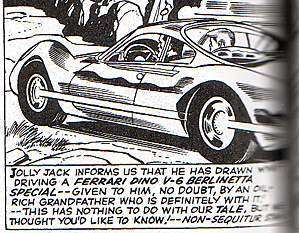
According to the Ferrari web site, this was one of the most
influential models ever, and was unveiled at the 1965 Paris motor
show. The Paris show takes place every two years, in September.
and it takes a little while for orders to be delivered, so it
would have started to appear in America in 1966. Indeed,
everything points to this being the defining car of 1966 and no
other year, firmly fixing this story to the real world.
Other developments:
It's not only Johnny who grows and changes. Reed changed just as
much. Four years earlier he was a pipe-smoking respectable
tweed-suited university figure. Then, four years later, he's a man
of action! (If it looks like he's got younger, that's because
stretchy skin doesn't wrinkle!) Ben's personality and appearance
have changed dramatically, just compare the careless violence of
the first few issues with the teddy bear he became. Sue has
developed from air-headed socialite to mother figure. Even the
Baxter Building has changed, from an ordinary office block to
almost a robot in its own right.
Galactus in 1966
1966 was dominated by Galactus. The Galactus saga has often been
imitated and retold, but all the retellings have been forgettable.
Perhaps this is because the saga is so clearly rooted in the mid
1960s. Just look at the climax to the Galactus trilogy, in issue
50. The cover makes space for the fact that Johnny Storm begins
college. Clearly the passage of time is rather important!
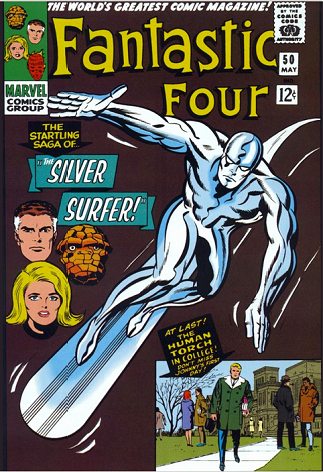
The art screams mid 1960s:
The cover to issue 48 and numerous backgrounds show the classic
early 1960s new York skyline. Most pages show classic 1960s
hairstyles. Most pages show classic 1960s fashions - the women
have push-up bras and the men (bystanders) wear hats. Several
panels show 1960s technology, with giant TV cameras, 1960s jet
planes, 1960s cars giant two-way radios, and so on. I don't have
the expertise to identify specific fashions from specific years,
but I bet that a fashion expert could identify the details.
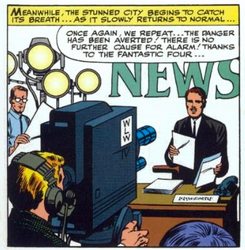
The attitudes are 1960s:
Issue 48, page 14 shows classic gender roles, with Sue worrying
about her duty to make dinner for Reed, and Johnny comments on the
battle of the sexes. And a silver muscle-bound spaceman riding a
surfboard - need I say more? But soon after we see the Black
Panther, the first ever (?) black superhero, pre-dating the
political group of the same name. This reflected the high profile
race issues of the mid 1960s, and would be up to the minute in
1966.
Pop culture of the mid 1966:
All the major elements of the story make most sense in the
1960s. The interest in godlike men and nobility, and clear
influence from movies like "The Day the Earth Stood Still" and
"The Day the Earth Caught Fire" and issue 48 page 13 directly
references a 1960s film maker.
Other 1960s references:
At the ends of issue 50 we learn that Wyatt Wingfoot was brought
up in a mission school. Issue 48 includes a photo montage that
looks very dated in today's computer age. And so on and so on.
This story, like all the others, is saturated in contemporary
culture and references. If we ignore the 1960s links then we must
ignore the art, the dialog, the premise... nothing is left! If the
Galactus story and the other stories have any merit, then some of
it must be down to real-time real world links.
It is worth noting that Marvel did not just reflect 1960s
culture, it contributed to it! That is what happens when you
embrace the times you live in and try to live in the real world.
In contrast, modern Marvel stories take place in an imaginary
limbo and declining sales reflect their lack of relevance.
1967-1968
The years 1967 to 1968 are dominated by Franklin. In 1967 Sue announces that
she is pregnant, and in 1968 the baby is born. This is the beginning
of the end for Real Time, though the process is gradual. Time
slippage is not obvious until the early 1970s, and does not produce
huge problems until the 1980s. It is not until 1991 that the last
nail is driven into the coffin of the Marvel Universe as it existed
in the 1960s, but that is another
story.
Although it is possible to interpret the Fantastic Four as living in
real time until 1969/1970 (issue 98, the real world moon landing),
it gets harder after issue 52. Another multi-issue epic began in 52,
and the events of just a few days (perhaps a couple of months at the
most) are stretched over nearly a year. Fans began to notice that
time was stretching. They started to complain. So much so that this
is acknowledged on the splash page of issue 61:

1969

A close reading shows that all the issues up until the 70s (when Sue
is pregnant) take place with very few gaps in between. We cannot
then have a long "catch up with real time" gap because Sue is then
pregnant, and we cannot have a pregnancy lasting two years! So real
time becomes hard to believe after the 50s (that is, after 1966).
However, the gap between Marvel Time and Real Time is still very
small, and the events of these issues take place with such energy
that most readers probably did not notice. The last major real time
event in the 1960s was in 1969, where the Fantastic Four help Neal
Armstrong get safely to the moon. (Issue 98 was dated 1970, but was
probably on sale in late 1969). If we do not pay close attention we
could still believe that events maybe happened in real time until
that point, but after that the problems just mount up. There are
occasional Real Time references for the next ten years, but these
are outnumbered by the obvious anachronisms.
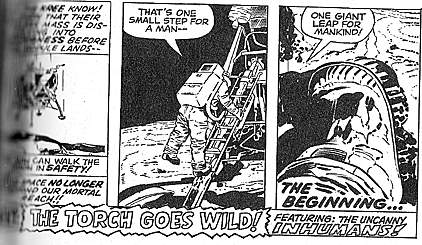
The same analysis can be done for other titles
The same examination could be made of other titles. For
example, in X-Men 54, in 1968, Scott and the X-Men take Alex
out for drinks after his graduation. The drinking age in New York
State at the time was 21, and Scott is older than Alex. Scott was 17
in 1963, so 22 in 1968. If any less time had passed then his younger
brother would be under 21 and unable to drink.
Another example is this footnote in HULK #135 (January 1971) by
scripter Roy Thomas:
"Roy's Theory of Relativity: Ever
since that infamous day in AVENGERS #9 (1964) when Kang first
invaded our century, his rate of time-flow has gone forward at the
same speed as ours -- so that, just as seven years have passed for
Kang since then, it is now seven years later for us, as well! See
you in the letters-pages! -- Rascally"
As Tony of The
Wastebasket points out,
"The story specifically notes 1964 as
the year the Avengers were formed and the 'present' as being 1971.
So it seems that Roy Thomas was operating under the assumption
that the Marvel Universe was moving forward in real-time."
The remaining years fit into just five "real" years.
As Tom Brevoort implied, later Marvel years can be compressed into
only a few few real years. Whereas early comics would refer to
previous issues as "months ago," later stories usually happen
without a break. The various attempts to
map Marvel Time onto Real Time indicate that everything from
the end of real time (1968) to the late 1980s (real time) would fit
into around five years. At
that point, serious continuity ended. In other words, the
Marvel Universe ended, in real time, around 1973, and then Marvel
published those stories over the next few years.
1973
The End of Real Time
The final nail in the coffin of Real Time is FF 129 - 133, featuring
baby Franklin at roughly 18 months old - old enough to be play
outside in the dirt with minimal attention, but probably not walking
or talking very much. One of these stories is clearly linked to New
Year 1973, when Franklin should really be twice as old as he is
portrayed. This is the first clear example of dates not adding up,
thus destroying the illusion of reality.
Marvel Time goes downhill from there. By 1984 Franklin is five six
years old, and he was still five in 1998. By the year 2000, the
older characters' ages seemed to be almost going in reverse. You can
track the corresponding decline in sales,
as comics no longer feel relevant to real life. There have been
occasional good stories since then, but practically no character
development. To all intents and purposes, the period of dynamism and
change ended in 1973 at the latest.

More evidence for 1973
According to the 1998 Fantastic Four annual, Marvel Time
diverged from Real Time in 1973. You can check this on
Wikipedia (or at least you could in 2010): just look up "Earth
98." The key event was the death of Gwen Stacey.
It appears that Stan Lee subconsciously thinks of the Fantastic
Four as ending circa 1973, around the time that he left direct
control of the comics. Read his "Last Fantastic Four Story."
It cannot be set in the present, as the characters are wrong. But
it cannot be set in the future either: the team (and the Silver
Surfer) seem inexperienced, they are short of money, and no recent
characters are present. Meanwhile, characters Like Thor, Captain
America and Nick Fury are not their current versions. Crucially,
Franklin looks younger. A discussion on the comicboards Fantastic
Four message board concluded that the story only made sense if set
in the early 1970s.
Philosophically, the concept of a "last Fantastic Four" story
implies a continuity that moves forward and is never retconned.
This was only true in the early days. So it cannot refer to the
modern comic called "Fantastic Four" where nothing ever changes.
Economically, the concept of "last Fantastic Four story" only
makes sense in the early 1970s. Today it is unthinkable that
Marvel would ever cease publication, as long as a handful of
copies can be sold. But in the early 1970s Marvel seriously
considered that superhero comics would end.
"Comics had always been a
cyclical business, and almost everybody in 1971 thought that
super heroes must inevitably be on their way out again. That's
why there was such a gold rush on to find the next big
genre--sword-and-sorcery looked like it might be a contender,
and there were a lot of new mystery (watered-down horror comics
without much horror), war and western comics being churned out
in this period. But the classic Marvel, Stan's Marvel, was still
seen as something of a fad (even by Stan himself), and the
common wisdom was that everybody was going to be doing something
else very soon (possibly in another field entirely.)" -Tom Brevoort
Real dates still used in the 1970s
The effects of Marvel Time were gradual. Some books still referred to
real dates (both in the past ad present) until the 1970s. This is from
Marvel Two In One (the Thing's own book) in 1977, referring to the death
of Adam Warlock (see FF 67 for his origin as "Him" and FF 274 for his
Warlock identity).


it may be symbolic that real time appeared mainly on grave stones. Real time was dying.
The Fantastic Four featured real dates until 1989
The Fantastic Four age by 13 years, but their stories take place
on real, fixed dates over their 27 calendar years, and earlier. In
1976 they referred to 1961, and in 1980 they knew it was 1980:

Dates were fixed as late at Act 5, in FF309 for example. In 1987
the space shuttles are grounded as a result of the Challenger
disaster of 1986. This is reflected in the story, and in that same
issue Ben refers to fighting in "the big one", WWII, a fact
established back in issue 11. But after 1991 there is a different
Ben who does not have that experience.

Why does Ben does notice that he is aging more slowly than the
people around him? Blame Franklin.
Note that this is not just some slip by Englehart: Byrne's last
story is about Marvel Time, and in his second to last story he
anchors Nick Fury's teenage years to 1936. Byrne has Sue state
that she was not born in 1936, but she also says she was only 12
years old when Reed was in college. This allows for Reed being
active in WWII (see FF11), without confusing new readers.
Regardless of what Byrne may have intended, those are the facts as
presented in his comic.
After 1989 the stories detach from the real world
Time started breaking in 1989. By 1991
time was in chaos and the the
coherent Marvel Universe was dead. In the 1998 FF annual for
example, The Thing can visit the real time Fantastic Four and see
that they are different people.
This illustrates the difference between a stretching timescale and a sliding timescale. Stretching time means the
characters themselves age slowly but do not notice: they are still
anchored in the real world. Sliding
time means that dates for events constantly change: all anchors to
the real world are broken except the present day, and without a
history the present is meaningless. In the sliding timescale (the Franklinverse) dates are
usually not mentioned at all, characters often grow younger, and continuity is treated as a
problem and best ignored.
Conclusion
That is how Marvel Universe continuity began, and how it no
longer exists. For how it ended, click
here.
Maybe one day the Fantastic Four will return to the real world.
Maybe one day we will again have characters that develop, stories
that are relevant to the present day, and events that have real
significance. But until that day we always have the reprints.
The team's ages
This might be a good time to look at the team's ages. The key
text is the letters page in FF11:

- Reed and Ben
Reed and Ben are later 30s, that is, 36-39, and were thus born between 1923 and
1926. This makes them at least 21 when WWII ended, consistent
with fighting in the war (in FF11), and Ben being a pilot. Ben
is two years older, as FF11 says he fought in Guadalcanal, which places
him as an air ace in 1942-43. Note that Ben's rocky skin and Reed's elastic skin disguise their
true age, but neither make any mention of aging toward the end, so
this argues for them being on the younger age of the scale.
However, they were de-aged in FF214 so all bets are off. The main
reason for assigning them the youngest possible age is to make
things simple: it prevents having to explain to shocked younger
readers who cannot imagine a 56 year old doing anything
physical. Reed and Ben met at college, so this argues for
them being the same age.
- Johnny
Johnny is "just seventeen". This suggest his birthday has only just
occurred, but when is that? I argue it is the cover date, February 1963,
and not the date the comic was written (late 1962). See below for why.
- Sue
Sue is "in her twenties" in 1962, and so would be born between and
1932 and 1941. But there is evidence that she was actually born
in 1929 or 1930: let's look more closely at Sue's real age.
Sue's real age
In the FF291 dream, Sue implies she was 20 in 1961, when Reed was in his
late 30s. This dream contradicts what Reed said about them as being
children together. All the evidence indicates
that there is a very simple reason: Johnny is Sue's son, born when she
was aged 16, and this would have been a social scandal. But how could a
31 year old get away with claiming to be a young 20-something? Sue was
an expert at looking much younger than her calendar age:
- Her
unusual beauty:
her excellent genes means the always looked young - An obsession with cosmetics
this is backed by Reed's wealth, her fame, and her own family's
comfortable background. She will have the best people in the world
working on her.
- Her extreme privacy:
the public didn't know her until she was 31, nobody knew her age, and
she allowed them to think she was "somewhere in her twenties" - Forcefields:
In later years, Sue appears to use her forcefield permanently and
unconsciously. In FF38 we learn that her forcefield automatically kicks
in
when needed, so we know that with practice she does not need to think
of it consciously. In another issue (sorry, I forgot the reference) it
is mentioned that her forcefield will automatically stop a bullet, even
when she's not expecting it, so it routinely hugs her body. By 232 it
seems clear that she is using it to enhance
her bust (see the notes to FF2321 and 232).
- In her 40s her body was de-aged to about age 28 by the Skrull ray (see FF214). The greatest makeover of all!
The desire to look young is one of many classic feminine stereotypes
represented by Sue, and has serious real world reasons. For millennia
older women have been ignored by men in favor of younger models, and at
the other end of the scale teenage girls who got pregnant (usually
against their wishes)
had to pretend an unwanted child was a sibling, and if necessary
pretend to be older to maintain the illusion.
Johnny: born in February 1946
The "just seventeen" statement comes from the letters page to FF 11.
We may be able to pinpoint this to the exact month. This is why.
- FF 11 would be aware of its cover date
The internal conceit is that all other issues report
the past: the team have an adventure, it's reported to Marvel, the book
is written, it goes on sale, and the cover date is ahead of that to
allow for magazines sitting on the stands for months. This means the
default dating for anything in the comic is at least 6 months before the
cover date. But issue 11 is different. FF11 is about the comic itself.
Marvel planned a special question and answer issue (we'll ignore the
second story for now), and asked
the FF for info. So if Marvel said "we are planning a special issue, how
old are you" Reed Richards would
naturally ask "on what date?" And Marvel would say "we are planning this
for the February 1963 issue." True, that would nbe on sale before that
date, but dates are late because
some kid in a remote town won't pick up the comic until then. (After
that date news stands can return the comics as being old.) We know from
the footnotes that the cover
date was important back then: references would often say things like
"see issue 4, April" or "see issue 6, August"
- Johnny was young, but wanted to appear as old as possible.
The art in issues 1 to 3
makes Johnny look young. 15 or so perhaps. But he wants to be seen as
equal to the others (hence storming off at at the end of issue 3: I
argue that most of his early solo adventures take place in several
months between issues 2 and 3). His while life is dominated by
frustration at being treated as the kid. So when asked his age, if there
is any way he can say "17" he will. Even if his birthday was on the
last day of the magazine cover date. I think Johnny's frustration is
something modern readers completely miss, and that is illustrated by his
love life. In modern times he is treated like a successful (and
shallow) womanizer. But in the early years he was the opposite: he cared
deeply, but devoted so much time to his work that he was romantically
very immature. He hated being treated like a little kid.
- The late date fits perfectly with the Sue's age
Sue's real age is based on the theory that she had an affair with Namor
as a teenager (see FF291). This was common in war time, and would be
most likely at times of greatest excitement, or when a boyfriend had
been away the longest. Reed served in Europe, so the latest date (and most emotionally charged period) would be Victory
in Europe, May 1945, or just before. The art and circumstantial details in FF261 (see
notes to that issue) suggest that Namor and Sue's romance climaxed at that time. If Johnny was conceived in May 1945 he would be
born in February 1946, and be "just seventeen" on the cover date of FF
issue 11, Feb 1963.
Objection: in FF 329, clone Johnny relives FF1 and says he's only sixteen (when according to the above calculation he should be 15). Response:
FF 329 takes place in a dream-like state where early and late stories
mix. For example, they are not sure whether or not Reed and Sue are
married. So this age refers to several years merged into one.The whole
point is that clone Johnny does not age.
Ages: conclusion
So the most likely ages are:
- Johnny was born around November 1945.
- Reed and Ben were probably born in 1926.
- Sue was probably born in 1929, but wanted people to think she was born ten years later.
- in FF270 Alicia says she was 19 when she met Ben. She was
chosen because of her resemblance to Sue, so Sue cannot have
been much older. This gives us Alicia's age and also confirms
Sue's, or at least the age Sue tries to appear.
Time progressed normally until Franklin's birth in mid-1968 (as
this page will show). At that point their ageing slowed
considerably, probably only adding 6 years (possibly 7) before the
Franklinverse took over and all connection with real time was
lost.
Real world dates
Quick summary: 1961-1968 is in real time. 1969-1889 covers only four comic years.
How dates are calculated:
The story was published over 28 years, but only takes around half
that time. There are
four ways to approach the problem:
- Ignore it. This means
never asking questions. This means missing out all the best
stuff.
- Slide it. The official
position is Marvel Time, the sliding
time scale. The origin story is always 13 years ago, and
the past is constantly revised. This means losing all the
contemporary details, but the stories follow the zeitgeist of
the time so closely that there is very little left.
- Stretch it. Until 1968 stories took place in real time. After the birth of Franklin they age slowly but do not notice. This allows us to continue to
connect modern comics to the real world. This is the explanation used in fourth wall breaking stories like She-Hulk.
- Anchor it. The Original
Marvel Universe blog, or OMU, anchors all stories in 1961.
Everything then takes place in the next 13 or so years. E.g.
1991 is really 1973; references to "Ronald Reagan" are really
references to Nixon.
Our preferred choice depends on our attitude to realism.
- Ignore it: If we don't
care then we don't care. period.
- Slide it. If we only
care a little then the sliding scale works - as long as we don't
look closely.
- Stretch it. If realism
is essential then slow aging fits with everything. No stories
need to be changed, although some stories may
be mis-reported. This is mostly a problem for other comics.
- Anchor it. If you want
maximum realism but also want to accept other comics, then some
changes are inevitable. To minimize changes you may need to
change the dates just once, and reject everything after 1991.
On this web site realism is everything. So I choose the stretching
method. The most compressed dates are toward the end of act 4. For how those final dates are calculated see the notes to FF annual 18
Summary of ages
| Act |
1:danger
|
2:rising
action
|
3:the
ball
|
4:crisis
|
5:triumph
|
key event
|
origin
|
Namor
|
Disliked
|
Father
|
Wedding
|
Galactus
|
Sidelined
|
Franklin
|
Agatha
|
Divorce?
|
Enough
|
Scratch
|
Hell
|
Peace
|
Sue: real:
(de-aged)
looks like:
|
31
20
|
32
21
|
33
22
|
34
23
|
35
24
|
36
25
|
37
26
|
38
27
|
39
28
|
40
29
|
41
30
|
42
(28)
31->28
|
43
(29)
"
|
44
(30)
" |
Ben
|
37
|
38
|
39
|
40
|
41
|
42
|
43
|
44
|
45
|
46
|
47
|
48(41)
|
49(42)
|
50(43)
|
| Reed |
35
|
36
|
37
|
38
|
39
|
40
|
41
|
42
|
43
|
44
|
45
|
45(39)
|
46(40)
|
47(41)
|
Johnny
|
15
|
16
|
17
|
18
|
19
|
20
|
21
|
22
|
23
|
24
|
25
|
26
|
27
|
28
|
year
|
1961
|
1962
|
1963
|
1964
|
1965
|
1966
|
1967
|
68-70
|
70-1
|
72-3
|
73-6
|
77-80
|
81-6
|
87-88
|
OMU
year
|
"
|
"
|
"
|
"
|
"
|
"
|
"
|
1968
|
1969
|
1970
|
1971
|
1972
|
1973
|
1974
|
key issue
|
1
|
4
|
11
|
27
|
an'l 3
|
48
|
72
|
an'1 6
|
94
|
141
|
189
|
214
|
291
|
an'l 20
|















































